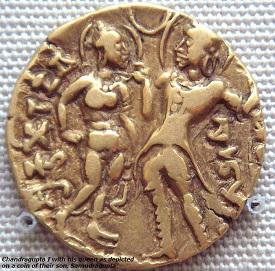A new dynasty, known as Gupta, emerged in north India. They made a permanent impact on Indian history by building up a large empire. They have firmly established several trends of Indian culture like the Mauryas a few centuries earlier.
Apart from political might and strength, the Gupta kings were also known for their great achievements in the field of science, art, culture, and literature.
The Allahabad pillar inscription of Samudragupta mentions maharaja Srigupta and maharaja Ghatotkacha as his ancestors. But we do not know much about the early Guptas.
I-tsing, a Chineses traveler, came to India between A.D. 671 and 695. He mentioned Srigupta as the builder of a temple at Gaya for the Chinese pilgrims about 500 years before his time.
The king, Srigupta, has been identified as the first Gupta king mentioned in the Allahabad pillar inscription.
Puranas also mentioned that the early Guptas controlled the area along the Ganga (the middle Gangetic basin), Prayag (Allahabad and surrounding region), Saketa (Ayodhya region), and Magadha.
Ghatottotkacha succeeded his father Srigupta. He was also referred as the Maharaja in Gupta records.
Samudragupta succeeded his father Chandragupta-I about A.D. 340. He earned a reputation as one of the greatest kings and conquerors. He was chosen by his father as his successor because of his qualities that would make him into a good king.
The Allahabad pillar inscription gives a detailed account of the career and personality of Samudragupta.
Harishena one of the officials composed the inscription and engraved on the Ashoka's pillar at Allahabad.
Samudragupta was a great military general. He had a long list of the kings and rulers whom he defeated and subdued as a part of his military achievements. He uprooted nine kings and princes from the Aryavarta and annexed their kingdom.
Campaign of southern India was the most important campaign of Samudragupta
Altogether twelve kings and princes of the south (dakshinapatha) are listed in the inscription.
During the campaign of southern India, he adopted the policy of first capturing the kings, then releasing them from captivity, and then reinstalling them as kings in their territory. By showing royal mercy, he won their allegiance.
Samudragupta proceeded for his south Indian campaign, through the eastern and southern parts of Madhyadesha to Orissa and then advanced along the eastern coast and reached Kanchi and beyond and returned to his capital by way of Maharashtra and Khandesh.
Samudragupta performed ‘Ashvamedhayajna’ after his several conquests and issued gold coins depicting the sacrificial horse and bearing the legend, which conveying that he performed the Ashvamedha sacrifice.
The Allahabad pillar inscription also lists fourteen kingdoms bordering his kingdom. These rulers paid tribute followed his orders and showed their obedience by attending his court.
These were located in eastern Rajasthan, northern Madhya Pradesh, Assam, and Nepal. Further, some forest kings (atavika-rajas) are mentioned whom Samudragupta had made his ‘Paricharaka’ (helpers).
Other political powers listed in the inscription are such as Kushanas, Sakas, Murundas as well as Simhalas (Sri Lanka) and inhabitants of other islands. These rulers sent embassies to Samudragupta's court.
Meghavarna, the king of Sri Lanka, sent an embassy to Samudragupta for his permission to build a monastery and a guest house for Buddhist pilgrims at Bodh Gaya.
Samudragupta was a versatile genius. He was called as ‘Kaviraja’ i.e. the king of poets. He was proficient in war and sastras as well.
The Allahabad pillar inscription calls him a great musician. This is also confirmed by his lyricist type of coins, which shows him playing veena (lute).
Chandragupta II was the son of Samudragupta and Dattadevi and he was chosen by his father as his successor.
The Gupta Empire reached its highest glory, both in terms of territorial expansion and cultural excellence under Chandragupta II.
Chandragupta II had inherited a strong and consolidated empire from his father Samudragupta.
Chandragupta II had established a matrimonial alliance with Vakatakas by marrying his daughter Prabhavatigupta with Rudrasena-II of the Vakataka dynasty.
Chandragupta-II made an alliance with the Vakatakas before attacking the Sakas so as to be sure of having a friendly power to back him up in Deccan.
Prabhavatigupta acted as a regent on behalf of her two minor sons after the death of her husband Rudrasena II.
Chandragupta-II’s victory over the mighty Sakas dynasty was his foremost success. The annexation of Sakas’s kingdom comprising Gujarat and part of Malwa strengthened the Gupta Empire, but also brought it into direct touch with western sea ports. This gave a great motivation to foreign trade and commerce.
Ujjain, a major centre of trade, religion, and culture became the second capital of the Gupta Empire after the conquest.
After the victory over Sakas, Chandragupta-II adopted the title of ‘Vikramaditya.’
Chandragupta-II issued dated silver coins to commemorate his victory over Saka kshatrapas.






